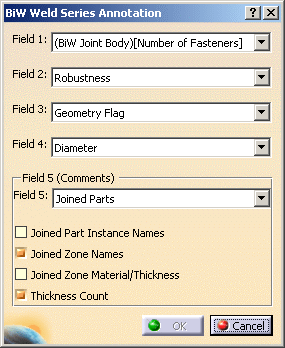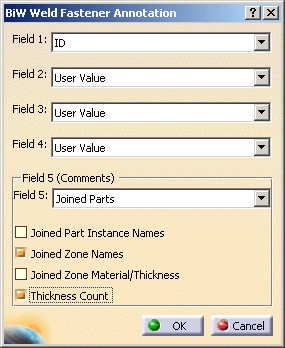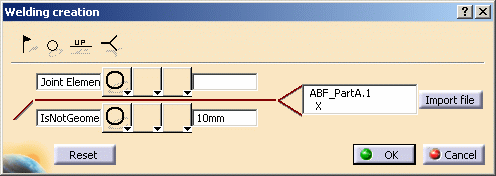Open the ABF_AllTypeFast_02.CATProduct document.
-
Click either BiW Weld Series Annotations
 or BiW Weld Fastener Annotations
or BiW Weld Fastener Annotations
 in the BiW Annotations toolbar.
in the BiW Annotations toolbar.The BiW Weld Series Annotation or BiW Weld Fastener Annotation dialog box is displayed. You can notice that both dialog boxes are similar: 

-
Select a parameter in each field.
Attributes are displayed according to the standard.
Use the most recent standard to get the parameterization of the functional annotations. If you use a former standard, fields are not valuated and are set to User Value.
Refer to Customizing the BiW Fastening Application Standard File in the Automotive BiW Fastener User's Guide. - Field 1: (depending on the annotation type)
- Fastener Annotations: Fastener ID parameters
- Single ID, or ID and Process Type
- Series Annotations
- Joint Body - [Number of Fasteners]
- Joint Body Name - [Number of Fasteners]
- Joint Body Name - Process Type
- Joint [Number of Fasteners]
- Joint Name [Number of Fasteners]
- Joint Name - Process Type
- User Value
- Fastener Annotations: Fastener ID parameters
- Field 2: Engineering Class Parameters
- User Value
- Robustness or Finish or Regulation
- Field 3: Manufacturing Class Parameters
- User Value
- Geometry Flag or Inspection Flag or Manufacturing Code
- Field 4: Shape Parameters
- Diameter or Length or Height or Material
- User Value
- Field 5: information frame
- Joined Parts
You can choose to display:- Joined Part Instance Names
- Joined Zone Names
- Joined Zone Material/Thickness
- Thickness Count
- Process Type (in this case all parameters above said are unavailable)
- Process Type [Robustness] (that is Process Type and Robustness) (in this case all parameters above said are unavailable)
- User Value (in this case all parameters above said are unavailable)
- Joined Parts

For further information about these options, refer to Displaying Joined Parts Information in a Balloon. - Field 1: (depending on the annotation type)
-
Point out a fastener in the 3D geometry or in the specification tree.
The Welding creation dialog box is displayed: 
The dialog box updates as you fill in the fields. You can select the symbols of your choice from the combo lists: they are not associated with the Process Type. -
Click OK to create the annotation.
- Annotations are created in the view plane: if there is no activated annotation plane during the creation, an annotation plane is automatically created parallel to the xy plane.
- They are positioned according to the fastener type: at the location point for a spot or along the curve for a curve bead.
- They can be attached to any type of fasteners but they are always visualized under the Welds node in the specification tree.
- They are associative with their attached fastener.
- If the engineering class parameter (Field 2) of a fastener is set to U (for Unspecified Value), the field corresponding to the associated annotation will not display any value.
If the annotation is associated to a spot point whose process category is set to Welding and process type to Resistance, the symbol is automatically valuated. The display of the symbol depends on the standard defined in Tools > Options > Mechanical Design > Functional Tolerancing & Annotations, Tolerancing tab:
for JIS standard and
for any other standard.
Modifying and Editing a Functional Annotation
- Functional annotations (except for datum associations) are
associative with their attached fasteners:
- if you modify the fastener's location or attributes (joined parts, ID, process type, etc.) and the update the product, the annotation is automatically re-positioned and updated.
- if you delete the fastener and update the product, the attached annotation is automatically deleted.
- if you select the fastener, all associated annotations are
highlighted both in the 3D geometry and in the specification tree,
providing 3D-Annotation-Query switch On/Switch Off
 is activated.
is activated.For further information, refer to Querying 3D Annotations in the 3D Functional Tolerancing & Annotation User's Guide.
- You can modify an annotation either by:
- changing its position:
- transferring it into another annotation plane
- moving it through drag and drop
-
mirroring
-
deleting it
-
editing its parameters
-
associative annotations: all the fields can be modified. However, if you modify by mistake a value set to an ABF attribute, the correct value is automatically restored once you update or check the corresponding fastener.
-
datum annotations: all the fields can be modified.
-
both annotation types: symbols can be modified
-
-
modifying the visualization plane of the annotation text
- changing its position:
- You cannot move an annotation independently from its annotation plane.
Creating a Datum Annotation
- Datum annotations are not associative with their attached fasteners: if you modify a fastener's parameter (location, process category, process type, etc.) and update the product, it has no impact on the datum annotation.
- Datum annotations can be moved anywhere in the geometry area as it always remain in the annotation plane.
- They have a particular display in the specification tree:

![]()